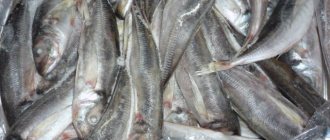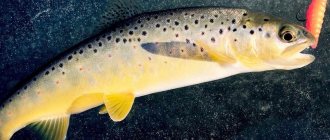Shelf life of fresh and live fish
If it is not possible to immediately prepare the product, it should be placed in the refrigerator. Species of fish that are least demanding of the composition of the water and the concentration of oxygen in it are allowed for live storage. For this purpose, retail outlets selling live fish are equipped with special aquariums in which proper conditions are maintained.
The taste of the future dish depends on the storage conditions of the fish.
The most important in this case are:
- water quality;
- temperature;
- oxygen content in water;
- absence of hydrogen sulfide and methane.
Water from ponds containing phytoplankton is considered unsuitable for keeping live fish.
Tap water must be dechlorinated before being used to store live fish, which is most easily done by blowing air through the water for 10-15 minutes. In addition, specialized filters and activated carbon are used to improve water quality.
Much attention is paid to water temperature. This is due to the fact that when the temperature is too high, pathogenic microflora develops in the water, and when the temperature is too low, the fish falls asleep.
The shelf life of live fish in aquariums installed in special stores is no more than 2 days.
When storing chilled fish carcasses, the main parameter is the temperature in the thickness of the meat and in the spine area, which should be within -1...-5°C. More pronounced cooling leads to freezing.
Chilled fish carcasses should be stored with ice in a 1:1 ratio. But such cooling is uneven.
It should be remembered that this may reduce the quality of the product due to injury and deformation. Products cooled by a cold liquid medium have higher quality.
In a refrigerator
The length of time fresh fish products can safely remain in the refrigerator depends on the temperature. If the refrigeration equipment is equipped with a special compartment in which the temperature is maintained at -2...0°C, fish can be stored for up to 3 days.
Shelf life of fish products in the home refrigerator.
At +5…+6°C the period should not exceed a day. You can extend storage a little by placing the product in a container and adding ice cubes.
In the freezer
In this case, the most reliable conditions for fish products are created. Fish is frozen if you intend to store it for more than 2 days. Place the products in the freezer in small portions, wrapping each in plastic.
Frozen fresh fish carcass can be stored for up to several months. Such storage does not affect the organoleptic properties or nutritional value.
Thaws a frozen semi-finished product for several hours. It is strongly not recommended to speed up this process with hot water or a microwave.
It should be remembered that repeated freezing of fish will dramatically change the density of the product and its organoleptic properties for the worse (thawed fish products cannot be frozen).
Shelf life of fish in the freezer.
At room temperature
It is not recommended to store fresh fish at room conditions, even for a short time. This product is perishable, and keeping it in room conditions can trigger the onset of irreversible processes.
Ready-made fish dishes can be kept at room conditions (for example, on the table) for 2 hours. After this period of time, it is recommended to put fish dishes in the refrigerator.
Vacuum packed
Vacuum packaging allows you to increase the shelf life of the product several times. During the storage period, the appearance, smell and taste of fish products are preserved. Modern technology of vacuum packaging with the addition of inert gases, used in industrial conditions, also eliminates the development of anaerobic bacteria.
The shelf life of fish products in vacuum packaging depends on the type of fish, its freshness and pre-processing.
Vacuum-packed fish can be stored for several months.
Salmon packed using vacuum technology retains its properties and does not spoil in the refrigerator for up to 1 month.
In attics or basements
Long-term storage of fresh fish in attics and basements becomes safe at low temperatures - less than -10...-15°C. Under such storage conditions, the product is frozen and can be stored for up to 3-4 months without losing its consumer qualities.
In a temperature range of -1...- 5°C, fish can be stored, packed with ice, for up to several days (48-72 hours). Raw fish products should not be stored at higher temperatures.
Sun-dried fish tolerates storage in attics and basements much better. For this, a cool room protected from excess dampness is sufficient.
Methods of soaking
When preparing salted fish, you need to remember a simple rule: the fish is soaked for as long as it was salted.
Many people mistakenly think that salt gives fish a special taste. This is wrong. During the salting process, excess moisture is removed from the fish. The salt dissolves in the liquid that the fish secretes and a brine is formed.
In order to prevent the proliferation of harmful bacteria, the resulting brine must be drained periodically. Fish salted with large amounts of salt can be stored for a long time.
Salty fish
There are several ways to soak fish, but they are based on a general technology that is suitable for soaking fish salted at home and bought in a store. This is the easiest way to soak.
When soaking, the salt from the fish carcass goes into the water. To speed up the process, use a larger container.
Soak should be in running or changing water. When using running water, the fish is placed in a colander and placed in a deep bowl. There should be a free distance between the bottom of the dish and the colander. Water will freely wash the carcass and flow over the edges of the container. This method allows you to soak the fish in 6 - 8 hours.
At home, fish are often soaked in changing water. To do this, the fish must be placed in a container with very cold water. To do this, take 2 liters of water per 1 kg of fish. It is enough to change the water every 1-2 hours during the day. You can use ice cubes to cool the liquid.
Using water has a significant disadvantage - it makes the fish meat watery. Therefore, it is better to use it for soaking salmon fish, since it is denser and more susceptible to harmful microorganisms.
For soaking fish, infusion of strong sweet tea. It improves the taste and is great for all types of fish. For the soaking procedure, it is enough to immerse the fish carcass in the prepared solution for 1 - 2 hours. The container should be stored in a cool place. Tea has a whole complex of tannins that prevent meat from becoming soft. To improve taste, you can use fruit and berry syrups.
Milk is well suited for soaking fish, as it quickly removes excess salt, reduces the specific fishy taste and smell, and makes the meat tasty and tender. The soaking procedure in milk lasts no more than four hours.
For soaking, chilled herbal decoctions of mint, sage, lemon balm, and oak bark are often used, which give the fish a specific taste.
You can use lemon juice to remove excess salt. The marinade is prepared at the rate of 1 part lemon juice and 3 parts chilled water. The fish carcass is placed in the marinade for 3 - 4 hours. Fish soaked in this marinade acquires a sour taste.
Fried, boiled and stewed fish
If the fish was not over-salted during the cooking process, you can serve it with an under-salted side dish. In this case, they will complement each other, and excess salt will not be so sensitive.
Salted fish can be used as a filling for pies. In this case, you should prepare unsalted dough.
We recommend reading: Task 11-5 On the Packaging of Canned Food There is an Inscription “Shelf Life in the Freezer (-180c) - 30 Days in the Refrigerator (-50c - 6 Days" How long can these Canned Food be Stored Without a Refrigerator at a Temperature of 200c?
Over-salted fish can be stewed in a thick sauce made from flour or tkemali.
Some housewives cook over-salted fish with mashed potatoes or rice, which absorb excess salt well.
To improve the taste of over-salted fried fish, sprinkle the finished dish with lemon juice and add a small amount of sugar. Then place fried fish and sautéed onions and carrots in layers in a deep saucepan and simmer for 10 minutes. Lemon juice can be replaced with lemon slices, then the dish will become more piquant.
You can add onions, grated potatoes or white bread softened in milk to over-salted minced fish. Unsalted rice, boiled until half cooked, works well.
If cutlets have already been prepared from over-salted minced meat, you can serve them with under-salted sauce. It is necessary to pre-fill the cutlets with sauce and place them in the oven for a short time.
To prepare dishes from salted soaked fish, you can use some tips:
- Vegetable oil will give the fish juiciness and mild taste. This is due to the fact that the fatty acids included in its composition, linoleic and arachidonic, dissolve well in vegetable oil and are more easily absorbed by the body;
- Mashed potatoes, rice, pickled mushrooms, boiled eggs or apples are perfect for a side dish;
- soaked cod, halibut, mackerel are ideal for making casseroles and grilling;
- soaked fish can be used to prepare dishes with the addition of ingredients that give a bright, rich taste: cream, vegetable oil, sour sauces. You should also take into account that the flesh of such fish will be slightly drier than fresh;
- It is not recommended to store soaked salted fish for more than a day. It is advisable to cook it immediately or serve it with the addition of butter or sauce.
Spicy salted fish
Spicy brining is distinguished by the use of a large number of spices and spices in the brine. It is used for salting herring, mackerel, and pink salmon.
Milk or water is often used to soak spicy salted fish. To do this, you need to prepare a large container. Pour milk or water into it so that the liquid completely covers the fish carcass. Add vinegar to the cold liquid at the rate of 1 part to 10 parts water so that the solution retains its sharpness and is not bland. Pour liquid over the prepared carcass and leave it in the refrigerator for several hours.
red fish
To soak red fish, you need to prepare additional ingredients. It is recommended to add cherry syrup to the hot marinade for soaking.
First remove the fish from the fins, tail and head. If desired, you can separate from the bones, remove the skin and cut into pieces.
Then completely immerse the fish in the hot marinade. When the composition has cooled completely, it must be strained and poured over the fish again. Soaking can last from several hours to several days. The container with fish should be stored in the refrigerator.
When soaking red fish in a solution of strong tea, some people add berry syrup or vodka.
Most often, the fish is soaked in milk, which makes it soft. For this you will need fresh cold milk. The fish must be placed in a flat dish and filled with milk. The soaking time depends on the salinity of the fish.
To soak large fish, it takes from a day to a week, for medium salinity - several hours.
Dry fish
In order to soak dry fish, you need to first soak it in water and then soak it in milk or water. The soaking procedure will take several hours. It should be remembered that lightly salted fish has a limited shelf life. It needs to be used in a short time. It has a delicate taste and a high content of nutrients.
Express method
To speed up the soaking process, it is recommended to use this common method, which is well suited for preparing small-sized fish.
The carcass should be cut lengthwise along the spine without damaging the skin. Then pour in a solution of strong sweet tea, which, thanks to the tannins included in the composition, will not allow the pulp to soften and lose its taste.
To speed up the soaking process, you can immerse the cut carcass in hot water for two minutes, then quickly remove it and place it in a container under cold running water. This method allows you to reduce the amount of salt and soften the taste.
I put 1 kg of over-salted salmon fish in 2.5 liters of boiled water overnight and added 10 peppercorns, 1 small bay leaf, zest of the tip of a lemon (2 tsp) and 20 ml of vodka as a preservative. In the morning I took out the fish, dried it with a paper towel and coated it with odorless sunflower oil. The result was an amazing lightly salted fish with a light lemon aroma.
Before soaking the fish, you need to rinse it thoroughly under the tap in cold water. If the meat of the fish is dense (sockeye salmon, perch, cod, flounder, burbot), then the salted fish should be soaked for 5 to 10 hours . During this time, you should change the water two or three times. As far as I know, salted fish is usually soaked for as many hours as the number of days it has been salted.
Lightly salted fish is used to create some traditional Russian dishes. But before using such a specimen, it is necessary to carefully gut it, remove unnecessary gills and head, and rinse thoroughly with fresh water.
How and how long to store dried and dried fish
Only fish of high quality and without signs of spoilage, such as an unpleasant odor, are allowed to be stored dried. The storage room for dried fish should be cool.
Good fit:
Storage temperature for smoked fish.
- pantry without windows;
- shaded balcony;
- attic.
It is recommended to wrap fish carcasses with parchment paper or tracing paper. Large fish are wrapped individually, and small fish are wrapped in small groups. This will prevent it from drying out.
The bundles are hung in places where the sun's rays do not reach. The recommended air humidity in such a room is 70-80%. At higher humidity, the fish will become moldy. Drier air in storage will cause the product to dry out.
Fish varieties with low fat content are suitable for dry storage. The best method is to store dried fish carcasses, wrapped in plastic, in the freezer. After removal from the freezer, such a semi-finished product needs to be dried.
Dried fish carcasses wrapped in paper are stored in the refrigerator for a long time. In this case, they are suitable for consumption for six months.
Large quantities of dried fish products can be stored in cardboard or wooden boxes, covered with fabric. In this form, the product can be stored for 6 months.
Storing fish on the balcony
Smoked meats can be stored in an ordinary living room, on a windowsill, for an average of 12 to 24 hours. In this case, the room must be constantly ventilated.
Storing smoked fish on the balcony in a box
Another important condition is that only windows located on the shady side of the house are suitable for keeping fish on the windowsill. If you have to store smoked meats at home, it is better to take them out onto the balcony. It can only be used as temporary storage at temperatures up to +6 degrees.
The product should be placed in a wooden box or corrugated cardboard packaging. It is advisable to separate each fish with a layer of parchment. To maintain a low storage temperature, you can add some edible ice.
The products can be stored in a suspended state for 72 hours.
How to do it correctly:
- Pull the fishing line;
- Place items in cotton bags.
- Add a clove of garlic to each of them.
- Hang it in the fresh air.
How to store salted and lightly salted fish
The shelf life of salted fish is directly proportional to the amount of salt used. The presence of brine significantly increases the permissible shelf life of salted fish.
At temperatures 0…- 3 °C, shelf life depends on the type of product:
- lightly salted salmon can be stored for 2 to 3 days;
- herring - 15-20 days;
- mackerel with high fat content - from 7 to 10 days.
Lightly salted fish without vacuum packaging is usable for a maximum of 5-6 days; and marinated, medium-salted fish products can be stored for up to 2 weeks.
For the longest time - up to 3 months - you can keep herring, salmon and salmon carcasses cut into pieces in the refrigerator, provided they are filled with vegetable oil.
Factors preserving the quality of salted fish.
How to properly soak salted fish at home
Salt is one of the most indispensable seasonings in the kitchen. Its moderate amount improves and emphasizes the taste of the dish. But sometimes it happens that the amount of an ingredient is exceeded, and it seems that the dish is hopelessly spoiled. There is a solution to the problem. Experienced chefs know how to correct the situation by soaking .
Lightly salted fish is used to create some traditional Russian dishes. But before using such a specimen, it is necessary to carefully gut it, remove unnecessary gills and head, and rinse thoroughly with fresh water.
We recommend reading: How to Store Unripe Pumpkin
Excess salt is removed by soaking. The fish is placed in cold water to swell, cleaned of scales, the head and fins are cut off and stripped. When fish is soaked, some of the mineral salts, soluble proteins, and flavoring substances pass into the water, which reduces the nutritional value of salted fish dishes. You can soak the fish in replaceable and running water.
The soaking process is dictated by two factors: firstly, to preserve a pleasant and delicate taste, and secondly, for reasons of maintaining health. The soaking time for salted fish is from 8 to 12 hours. Soaked fish is used for boiling, frying, preparing cutlet mass and stewing.
The technology for soaking salted fish may vary depending on the type and degree of salting. If desired, the taste can be changed using spices. It all depends on preference. The degree of salting for cooking is 5%, for frying - only 2%. Large and heavily salted ones will have to be soaked for a day or more.
Shelf life of canned fish
Both fish carcasses, cut into pieces, and offal (for example, cod liver) are canned. The shelf life of canned fish products does not exceed 2 years.
The period during which canned fish products retain their beneficial properties and do not spoil does not depend in any way on the composition of the sauce or on the spices added during canning.
After opening, it is recommended to transfer the contents of the can into a porcelain or glass container. SanPiN prescribes storing opened canned food for no more than 24 hours.
How to store ready-made fish dishes
Ready-made fried or boiled fish dishes should not be left on the dining table for more than 2 hours at room temperature. After this time, you need to place them in the refrigerator, and then they will be usable for another 2 days.
It is recommended to store ready-to-eat Japanese dishes in special sushi chambers for no more than 48 hours.
We are talking about blanks for making rolls, carcasses cut into pieces. Already made rolls cannot be stored.
The shelf life of fish oil capsules is 2 years.
Storing fish outdoors
To preserve its taste and nutritional properties, any meat needs a cool environment around it. In nature, you can build a small improvised cellar for this purpose. Any cellar is a pit, the top of which is well covered. It is not necessary to dig a deep and large hole.
A small depression in the ground will suffice to place the carefully wrapped fish. You can also place the product in a sealed, durable bag and leave it submerged in water. To prevent the package from floating away, it should be tied to shore structures. If there are none, you can specially dig a pole into the ground and fasten the cord to it.
Read more ► Storing minced meat in the refrigerator and freezer
When it is not possible to provide the fish with a cool storage temperature, it is better to eat it quickly and throw away the excess. Otherwise, the product will quickly begin to deteriorate, and the risk of poisoning will increase.
Signs of fish spoilage
It is possible to determine that fish products have begun to deteriorate without conducting laboratory analysis.
Signs of poor quality fish.
A product that has begun to lose its consumer qualities has the following signs:
- unpleasant odor;
- the presence of mucus on the gills;
- change in gill color from a natural red tint to gray, brown, greenish;
- cloudy, sunken eyes that are gray or brown;
- in naturally brightly colored fish, the bright shades disappear and become faded;
- the mucus covering the carcass becomes sticky, increases in volume, and clots appear;
- the elasticity of the meat decreases: when pressed, a dent remains that does not straighten out for a long time (in this way you can determine the freshness of both fish carcasses and fillets or steaks);
- the scales of spoiled fish fall off and come off easily;
- the meat in the ridge area takes on a reddish tint.
How to extend shelf life
If necessary, you can extend the shelf life of fish products using the following techniques:
- freezing (staying in the freezer significantly slows down destructive processes and extends the period during which fish products retain their nutritional qualities);
- vacuum packaging;
- drying (dried fish carcasses are stored much longer than fresh, raw ones)
- salting (at home you can salt both bream caught in the river and pink salmon, trout, and halibut bought in a store); You can store salted fish in a glass jar.
Catch storage methods.
Devacuation of packaging
When working with fish with bones and unpeeled seafood, the packaging may often be damaged by sharp edges and bones, and, consequently, the product will be de-vacuumed and returned.
Therefore, one of the key points when working with this group of products is the presence of the “soft crimping” option in the machine you choose.
The principle of operation of this option is that at the end of the vacuum cycle, air is not suddenly, but smoothly admitted into the chamber, due to which the vacuum bag does not quickly collapse under the influence of atmospheric pressure, but smoothly tightens the product, which avoids damage to the packaging.
The results of our tests showed that without using “soft crimping” the probability of damage to the package rises by 10% or more. Implementing this option will allow you to protect yourself from serious losses.
Do you use expired food for cooking at home?
Yes, the main thing is to process it if it is meat or expired kefir for pancakes.
27.72%
No, it is very dangerous and not useful.
36.37%
If the products have fungus or mold, then we throw them away; if they are a couple of days past their expiration date, we use them for food, even without heat or other treatment.
35.91%
Voted: 1952
Like many other products, fresh fish and seafood when refrigerated have a very short shelf life - 1-2 days. To expand opportunities for selling these products, the manufacturer needs to provide high-quality, technologically advanced packaging with increased shelf life.
The simplest way to achieve this goal is to pack in vacuum bags. Such packaging will ensure shelf life of up to 5–7 days at a temperature of 0.+2 C°. In addition, in addition to extending shelf life, vacuum packaging of fish and seafood provides a number of advantages:
When packaging chilled fish and seafood in vacuum bags, the manufacturer may encounter some problems:










